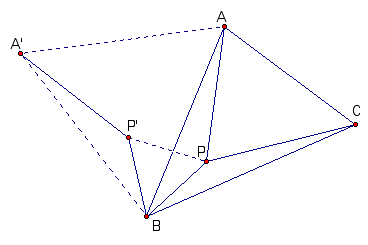

So in this exploration we want to look at the following problem:
First we want to consider the following acute triangle (ABC) and an artibitrary point P.

If we let B be our center point and reflect the triangle ABP about the vertex B 60 degrees, We get the following:

Now, since we rotated triangle ABP, we know that all of the distances are preserved. Therefore we know that BA = BA', BP = BP', AP = A'P' and angle PBP' is 60 degrees. Hence, the following equilateral triangles are formed: (PBP' and ABA')

From our memory about distances, we know that the short distance between two points is a straight line therefore, if we construct a line from A' to C, we would have the following:

In order for point P to be the minimum distance from each vertex in the triangle ABC, points P' and P must lie on the straight line.

Now, we can see that AP + BP + CP = A'P + P'P + PC which equates to a straight path from A' to C and this is minimal since it is a straight line.
Therefore, the sum of AP + BP + CP is the minimal distance at a point P since the angle BPC = 180 - 60 = 120 degrees and three sides extend an angle 120 degrees. The point P is called Fermat point.